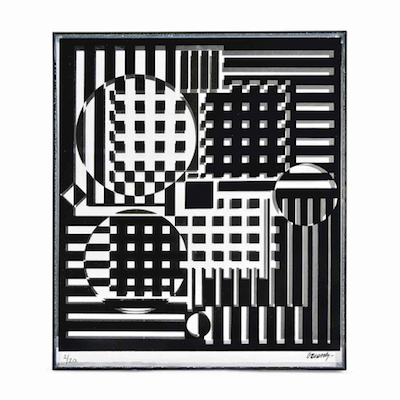


Details
Artist
Styles
Serigraph on parchment arranged in 11 columns on 8 membranes - signed and numbered from the edition of 180. Please note that the acrylic case is not included. // Yaacov Agam's Megillat Esther (1980) is a vibrant serigraph on parchment that reinterprets the traditional Jewish scroll of Esther. Structured in 11 columns across eight membranes, this piece features Agam’s signature use of dynamic colors and geometric patterns, arranged in bands and circles that interact with the text in the center. Each color and shape seems to pulse and shift, encouraging viewers to experience the scroll’s narrative through both visual and spiritual lenses. The artwork’s rhythmic arrangement draws from Agam’s deep connection to Kinetic Art, inviting the viewer to engage with the story of Esther in a uniquely modern format. Limited to an edition of 180, the piece exemplifies Agam’s fusion of religious tradition with contemporary abstraction.
Megillat Esther, 1980
form
Medium
Size
49.8 x 2.5 cm
- Inches
- Centimeters
Edition
Price
- USD
- EUR
- GBP
Details
Artist
Styles
Serigraph on parchment arranged in 11 columns on 8 membranes - signed and numbered from the edition of 180. Please note that the acrylic case is not included. // Yaacov Agam's Megillat Esther (1980) is a vibrant serigraph on parchment that reinterprets the traditional Jewish scroll of Esther. Structured in 11 columns across eight membranes, this piece features Agam’s signature use of dynamic colors and geometric patterns, arranged in bands and circles that interact with the text in the center. Each color and shape seems to pulse and shift, encouraging viewers to experience the scroll’s narrative through both visual and spiritual lenses. The artwork’s rhythmic arrangement draws from Agam’s deep connection to Kinetic Art, inviting the viewer to engage with the story of Esther in a uniquely modern format. Limited to an edition of 180, the piece exemplifies Agam’s fusion of religious tradition with contemporary abstraction.
- Recently Added
- Price (low-high )
- Price (high-low )
- Year (low-high )
- Year (high-low )
Yaacov Agam
Yellow Haze, From The Evolution Suite I, C. 1995
Limited Edition Print
Mixed Media
EUR 2,400
Yaacov Agam
Haggadah – Le Shana Haba’Ah (Next Year In Jerusalem), 1985
Limited Edition Print
Silkscreen
USD 450
Yaacov Agam
Haggadah – Had Gadya #3 (The Little Lamb), 1985
Limited Edition Print
Silkscreen
USD 450
Yaacov Agam
Haggadah – Had Gadya #2 (The Little Lamb), 1985
Limited Edition Print
Silkscreen
USD 450
Yaacov Agam
Haggadah – Had Gadya #1 (The Little Lamb), 1985
Limited Edition Print
Silkscreen
USD 450
What is Op Art?
Op Art is a visual art style that uses optical illusions to create the impression of movement, vibrating patterns, flashing, or hidden images. The works are typically abstract, with many well-known pieces in black and white. The roots of Op Art can be traced back to earlier movements like Futurism, Constructivism, Dada, and Neo-Impressionism, particularly in their use of color effects and graphic design.






















































